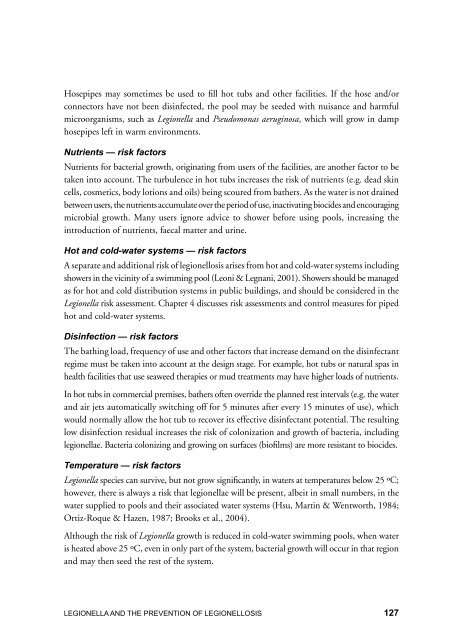LEGIONELLA - World Health Organization
LEGIONELLA - World Health Organization
LEGIONELLA - World Health Organization
You also want an ePaper? Increase the reach of your titles
YUMPU automatically turns print PDFs into web optimized ePapers that Google loves.
Hosepipes may sometimes be used to fill hot tubs and other facilities. If the hose and/or<br />
connectors have not been disinfected, the pool may be seeded with nuisance and harmful<br />
microorganisms, such as Legionella and Pseudomonas aeruginosa, which will grow in damp<br />
hosepipes left in warm environments.<br />
Nutrients — risk factors<br />
Nutrients for bacterial growth, originating from users of the facilities, are another factor to be<br />
taken into account. The turbulence in hot tubs increases the risk of nutrients (e.g. dead skin<br />
cells, cosmetics, body lotions and oils) being scoured from bathers. As the water is not drained<br />
between users, the nutrients accumulate over the period of use, inactivating biocides and encouraging<br />
microbial growth. Many users ignore advice to shower before using pools, increasing the<br />
introduction of nutrients, faecal matter and urine.<br />
Hot and cold-water systems — risk factors<br />
A separate and additional risk of legionellosis arises from hot and cold-water systems including<br />
showers in the vicinity of a swimming pool (Leoni & Legnani, 2001). Showers should be managed<br />
as for hot and cold distribution systems in public buildings, and should be considered in the<br />
Legionella risk assessment. Chapter 4 discusses risk assessments and control measures for piped<br />
hot and cold-water systems.<br />
Disinfection — risk factors<br />
The bathing load, frequency of use and other factors that increase demand on the disinfectant<br />
regime must be taken into account at the design stage. For example, hot tubs or natural spas in<br />
health facilities that use seaweed therapies or mud treatments may have higher loads of nutrients.<br />
In hot tubs in commercial premises, bathers often override the planned rest intervals (e.g. the water<br />
and air jets automatically switching off for 5 minutes after every 15 minutes of use), which<br />
would normally allow the hot tub to recover its effective disinfectant potential. The resulting<br />
low disinfection residual increases the risk of colonization and growth of bacteria, including<br />
legionellae. Bacteria colonizing and growing on surfaces (biofilms) are more resistant to biocides.<br />
Temperature — risk factors<br />
Legionella species can survive, but not grow significantly, in waters at temperatures below 25 ºC;<br />
however, there is always a risk that legionellae will be present, albeit in small numbers, in the<br />
water supplied to pools and their associated water systems (Hsu, Martin & Wentworth, 1984;<br />
Ortiz-Roque & Hazen, 1987; Brooks et al., 2004).<br />
Although the risk of Legionella growth is reduced in cold-water swimming pools, when water<br />
is heated above 25 ºC, even in only part of the system, bacterial growth will occur in that region<br />
and may then seed the rest of the system.<br />
<strong>LEGIONELLA</strong> AND THE PREVENTION OF LEGIONELLOSIS

















